WebSocket technology is at the forefront of real-time applications such as chat services, financial data streaming, and multiplayer games. In the era of blockchain, WebSockets represent a crucial set of tools for building Web3 applications and dApps. Read on to learn what WebSocket is, how the protocol works, and why it makes sense for developer platforms like Moralis to fully support WebSocket APIs. If you’ve kept an eye on Moralis, you will know that Moralis Speedy Nodes recently launched full support for WebSockets!
WebSocket is a communications protocol that allows for a constant flow of data over a single TCP connection. In this way, web applications may enjoy real-time communications between a client and a server. Before we go further, let’s break for a few definitions:
- TCP – A Transmission Control Protocol (TCP) allows messages between Internet devices within a network to communicate with each other. Most of the web applications that we are most familiar with today, such as browsers and emails, depend on TCP as part of the Internet’s communication transport layer.
- Client – The Client refers to whatever application you have open on your device (such as your favorite video game, trading app, or social media feed).
- Server – A server simply means a remote computer that stores the data that you want to receive or send.
WebSockets allow for a continuous line of communication between the client and server until that line is closed. As a result, it can remain open for back and forth, bi-directional communications. Let us dive deeper into the specifics of WebSocket, and why Moralis’ introduction of WebSocket support for Speedy Nodes is such a big deal. If you haven’t already, make sure to sign up for Moralis for free today to build dApps easily!
WebSockets vs. HTTP
To understand how WebSockets add many functionalities to web applications, let’s work through some of the differences between them and the HTTP protocol. HTTP is the request-response model that you’d see in a search for information. The connection opens to send the request for information. It then closes as soon as the server sends the response back.
Think of doing a Google search, which operates using the HTTP protocol. You type in a request for data, for instance: “What is WebSocket?”. Your browser fetches the most (hopefully) relevant data from its server and returns the information to whoever requested it. The person making the inquiry now has their answer (or, to be truthful, about 14,400,000 answers!).
Whether or not those +14 million potential answers are right, wrong or somewhere in between, the conversation is now over. Google is no longer searching on your behalf; the search is over.
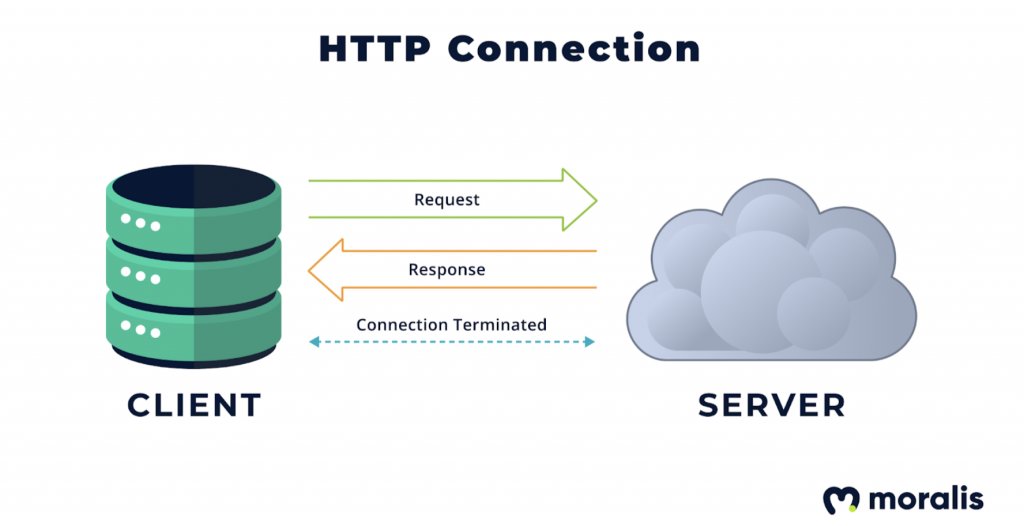
But what if brand new information is available after you ask your question? Maybe there is some important data about industry usage on WebSockets. Perhaps a new infrastructure project adopting the protocol just announced support for WebSockets. You will never know unless you ask again because your search was one-dimensional. It happened once and now it is over.
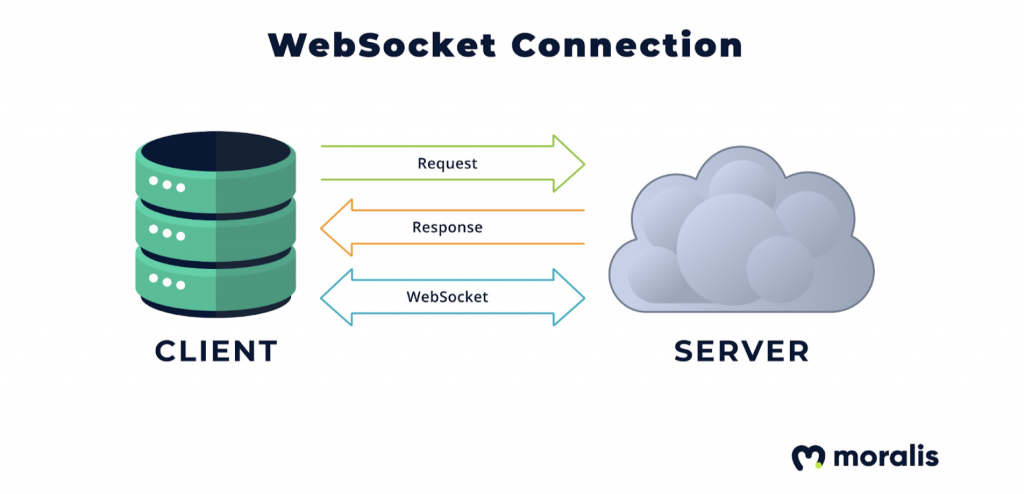
What WebSockets do is essentially extend the conversation between the client and a server. The conversation, instead of ending with that query, can continuously update in real-time and in a seamless, automatic way.
Developers building applications for modern companies require WebSockets to not only gain access to real-time data but also to reduce the overhead by using real-time data streams over costly, repetitive data fetching.
How does it work?
WebSocket and HTTP protocols both enable Internet communications. However, WebSockets provide a faster, continuous stream of data. HTTP is more suited for one-time data pulls. Check the chart below to review the main differences between WebSockets and HTTP and why they matter:
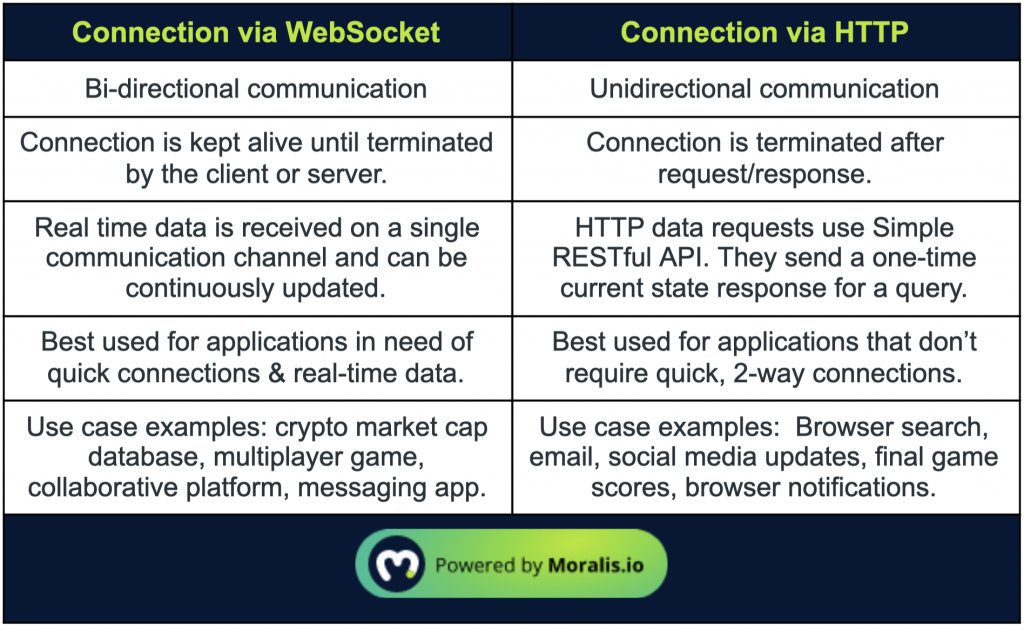
The WebSocket protocol allows for persistent communications in real-time. By using a bi-directional approach, the communication can stay open to constantly receive new updates. Developers can then build applications that make the most of real-time data. With the emergence of blockchain networks, WebSockets provide a key element in bringing distributed ledger data to a set of users for various functionalities.
Fun fact – WebSocket Protocol first became standardized by the Internet Engineering Task Force (IETF) through RFC (request for comment) 6455 in 2011.
5 Real-World WebSocket Use Cases
Now that you have had an in-depth review of the differences between WebSocket and HTTP, let’s move on to the real world significance behind this technology. It is vital to understand how different types of applications can benefit from using WebSocket APIs. These APIs are available to developers as part of the protocol’s SDK (software development kit) so they can build applications that enable the following features:
1. Collaborations
Imagine you are working on a Web3 application with a global team of engineers. WebSockets enable developers to work seamlessly together in real-time so everything that everyone is doing is live (or very close to it). No need to worry about merging each person’s latest work or wonder which version is the most current. All collaborators are on the same page with the open communications enabled by WebSocket.
For some people, a more familiar example is collaborating on a Google Doc or Sheet, where edits are instantly available to all those with access to the document. When any one person makes a change, it is in real-time for all involved. Attempting to do this with MS Word, which does not support Websockets for word processing, will slow the collaboration process.
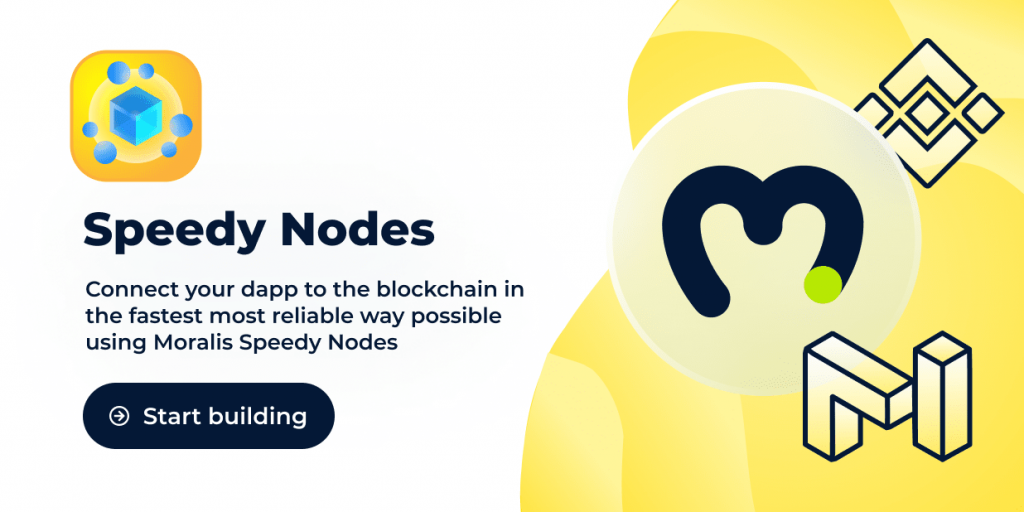
Learn how Moralis Speedy Nodes allow you to build serverless dApps in a snap!
2. Location-based apps
If you are using Google Maps to, e.g., make your road trip easy to navigate, what would that be like without real-time data? As you drive across Europe from Paris to Rome and get closer to your destination, you want the most accurate, real-time information. Once you cruise into Florence, you do not want instructions for driving from Paris. You want the latest possible information, such as how to get from Florence to Rome! Most drivers today enjoy real-time data when journeying to any destination, thanks to technologies like WebSocket.
3. Multiplayer games
Think of playing Apex Legends, Fortnight, or your favorite multiplayer game. If you do not have real-time data enabled by WebSockets technology, you will probably not fare very well in a head-to-head battle! Multiplayer games let people from all over the world play together. You can believe it is a better experience when the data coming and going between player, browser, and the server is continuous and as close to real-time as possible.
4. MultiMedia Chats
Imagine a messaging app that was as slow as email. That would be HTTP-style communications. WebSockets enable real-time messaging apps like Telegram and WhatsApp to create streamlined messaging communications for their millions of users.
5. Financial applications
With the dawn of blockchain technologies has come the open public ledger of transactions. Blockchain ledgers run 24/7 on hundreds of computers (nodes) all over the world at once. If you are using a trading app, you may have alerts set up to notify you when BTC price dips below $30,000. For this, you want real-time information. Not data from last week, yesterday, or earlier today. Blockchain-based dApps and Web3 apps need their data yesterday to stay competitive.
What is WebSocket API?
In your research, you may see WebSockets described as the WebSocket API, which means the same in a general sense. An Application Programming Interface (API) is known as middleware. In other words, APIs connect two applications and enable communications between the two. If you check the weather on your phone, you’re more likely than not using an API. Your app is probably linked through an API to another source of real time data, such as the National Weather Service.
Like other types of middleware, the user is rarely concerned with APIs. But developers use them to draw data into their apps and platforms. For instance, many crypto platforms allow you to set up multiple exchanges on one account. They use the API data feeds from the different exchanges to offer their users additional, real-time data and features.
WebSocket is a type of API technology that lets developers create two-way communication lines between a user’s browser and the application’s server.
WebSocket protocol support – browsers and beyond
All major browsers, including Chrome, Safari, and Opera, provide full support for WebSockets. With over a decade of browser support behind the WebSocket protocol, developers enjoy a wide array of documentation, plugins, and troubleshooting content to make their job easier.
Moralis is a Web3 development platform that vastly simplifies Web3 app and dApp development. By providing Speedy Nodes endpoint with WebSocket support and a fully managed, infinitely scalable Web3 backend, Moralis provides developers with the infrastructure they need to build for Web3.
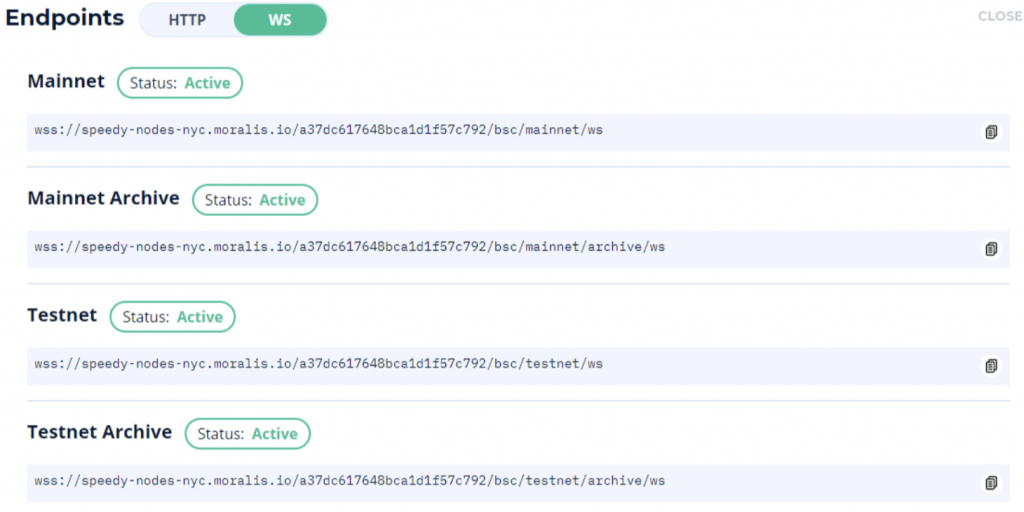
Speedy Nodes WebSocket Endpoints at Moralis
What WebSocket Integration means for Moralis
With Speedy Nodes and WebSocket integration, Moralis’ Web3 dApp building platform can offer features like:
- Cross-chain compatibility between the world’s most used blockchains, including Ethereum, Polygon, and Binance Smart Chain
- User management, sign-up interface, and authentication protocol for applications
- Simplified token issuance on multiple blockchains
- A complete NFT SDK for building NFT platforms and apps
- Real-time database management – something that is crucial in crypto markets.
- Smart contract monitoring
- Integration with IPFS data file storage for Web3
With even more features available, what stands out is the simplified UI of Moralis. It welcomes developers of all experience levels, inviting them to begin their journey to dApp development and become part of the Web3 revolution.
By adding the real-time capabilities of WebSockets, Moralis gives developers the capabilities they need to build cutting-edge blockchain-based applications. Developers and teams no longer have to worry about how to build and maintain their backend infrastructure. Moralis provides everything they need. From a web server and database management to full access to blockchain nodes, Moralis provides all the necessary tools building Web3 apps.
Now that WebSocket functionality is integrated at Moralis, developers have an enhanced layer of programmability and speed for building blockchain apps.
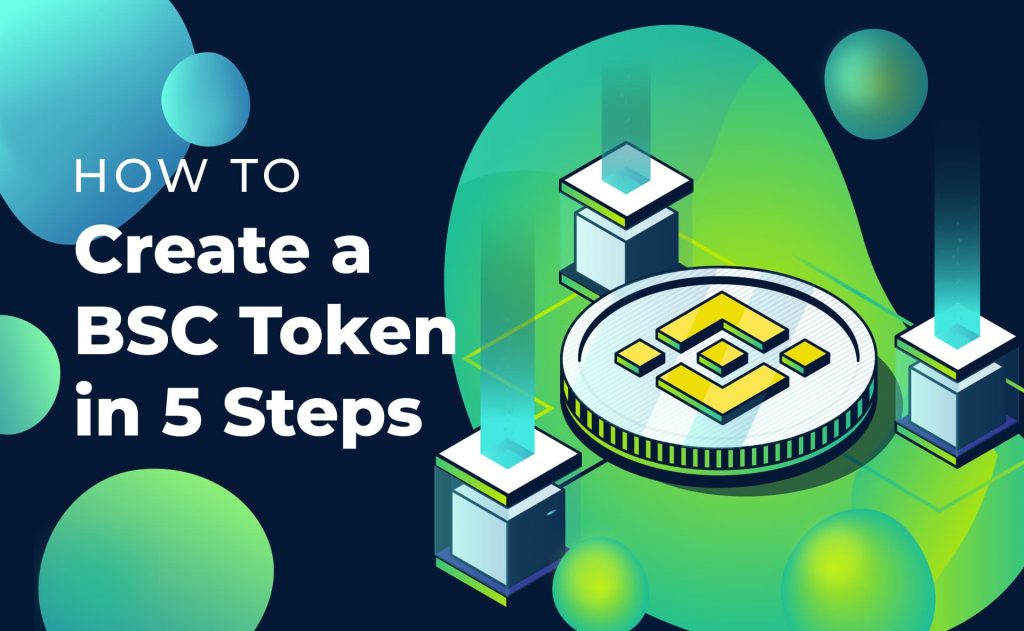
Create a Binance Smart Chain token in 5 steps using Moralis Speedy Nodes.
What is different about Speedy Nodes?
Unlike other node providers, Moralis offers a continuous connection with nodes of multiple blockchains. They are able to do so through WebSocket and other technologies. This allows the users to maintain an open line of communication where they constantly receive the latest information.
Blockchains like Ethereum operate 24/7 and store all transactions publicly, all the way back to the very first genesis block. Speedy Nodes and WebSockets enable developers to capitalize on the massive data made available by blockchains. Not only this, but Moralis’ accessible building platform and unique set of tools also make dApp development quicker and easier than ever.

Because Moralis provides the infrastructure and back end that developers need to build blockchain applications, this means that going to market will be a lot quicker and easier. Developers do not have to build their own backend first. They can simply use the Moralis platform to prototype, develop and deploy dApps and Web3 applications.
If you’re a developer ready to learn more about what you can build with Speedy Nodes and WebSockets, watch the video below for an intro to Moralis Documentation:
WebSockets add an exciting layer to web development – one that shines particularly bright in decentralized technologies. Open, public blockchains need an instant flow of data. With WebSocket APIs and Moralis Speedy nodes, creative development in the exciting crypto industry is boosted to max levels.
